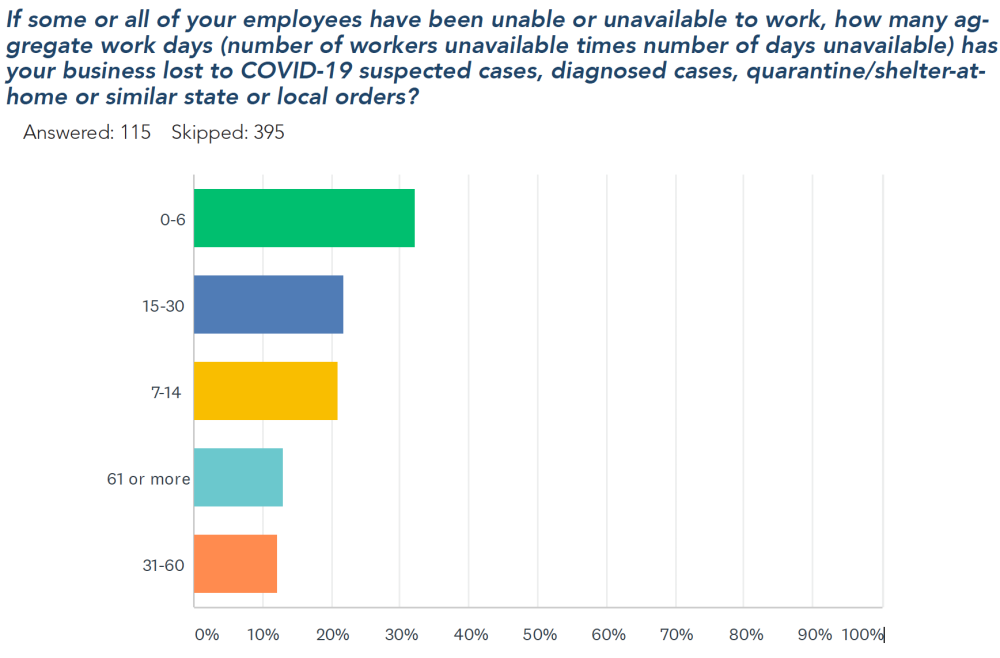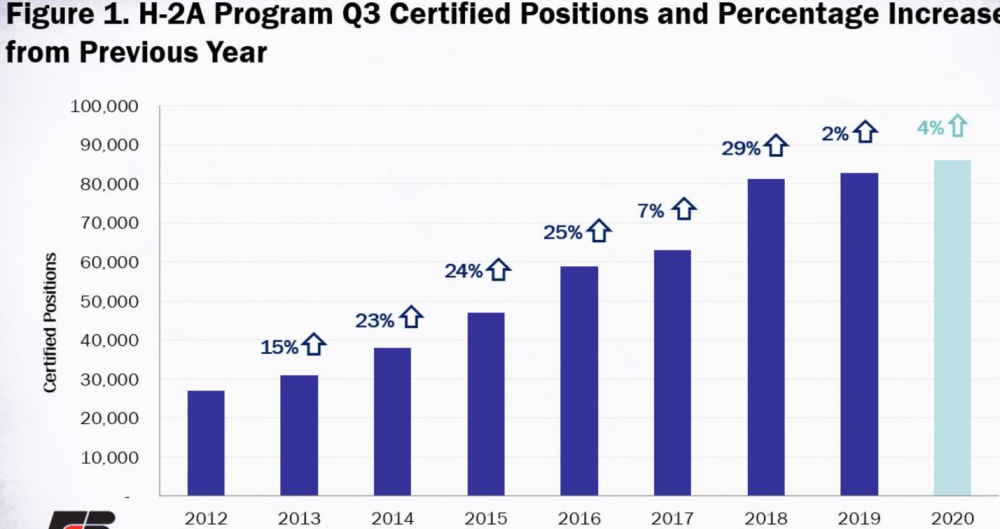The March-April 2020 lockdowns aimed at slowing the spread of the COVID-19 virus exempted essential food system and health care workers, so that farm, food processing, transportation, and supermarket workers continued to work while many other workers were laid off or worked remotely. There were predictions of farm labor shortages due to farm workers who had limited access to social safety net programs going to work while sick and spreading COVID-19 in often crowded housing.
After six months, there appear to be three major lessons from COVID-19 and farm workers: relatively few COVID-linked farm labor shortages in 2020, an expanding H-2A program, and an acceleration of farm labor changes that were underway before the pandemic.
First, despite expectations of farm labor shortages, there were few such reports in summer 2020. U.S. shipments of fresh vegetables were up one percent in the first nine months of 2020 compared with the same period of 2019, while fresh fruit shipments were down six percent. Since workers pick pounds and tons of fruits and vegetables, the amount of work to be done in 2020 was similar to the amount done in 2019.
The share of positive COVID-19 tests was higher-than-average in counties with larger agricultural sectors and a higher share of Hispanics in their population. Hispanics tested positive for COVID-19 at higher rates than other racial and ethnic groups, fueling a perception that farm workers were more likely to catch and spread COVID-19. Many of the COVID-19 cases detected in agricultural areas involved older residents of multigenerational households that included farm workers, nonfarm workers, and ex-farm workers.
However, most media reports failed to distinguish between farm and nonfarm workers. Some suggested that most farm workers are follow-the-crop migrants who spread COVID-19 as they travel, even though less than five percent of US crop workers have two farm jobs at least 75 miles apart.
California farm workers grappled with issues that ranged from high housing costs to poor quality air from wildfire smoke in 2020, but there were more reports of reduced worker hours due to larger crews than of employers complaining of too few workers.
A quarter of the farm employers responding to a summer 2020 California Farm Bureau Federation survey reported that work days were lost on their farms due to COVID-related employee absences. Over 85 percent of these lost-work-days respondents reported fewer than 60 workdays lost, equivalent to 10-six day weeks. Labor expenditure data from the Census of Agriculture suggests that 856 million hours were worked in California agriculture in 2017, equivalent to 107 million eight-hour days, making days lost due to COVID-19 a tiny fraction of days worked in California agriculture.
A quarter of California farm employers reported lost work-days due to employee COVID-19 concerns; 85% reported fewer than 60 work days lost

By contrast, there were frequent reports of labor shortages in meatpacking and food processing plants, where workers are in close proximity in sometimes cold and wet plants that facilitate catching and spreading COVID-19. Some food and meat packing plants employ thousands of workers in one location, and some had hundreds of COVID-19 cases.
One summary suggests that farm workers were more likely to contract COVID-19 away from work, while food processing workers were more likely to contract covid at work.
400 nonfarm workers tested positive for COVID-19 and eight died at the 3,700 employee Foster Farms complex in Livingston in August-September 2020
Second, the number of farm jobs certified to be filled with H-2A workers increased despite record unemployment rates, meaning that DOL agreed with farm employers that U.S. workers were unavailable. The number of jobs certified for H-2A workers rose especially fast in California and Washington in 2020.
The H-2A program expanded faster between the 3rd quarters of 2019 and 2020 than between the 3rd quarters of 2018 and 2019

Source: https://www.fb.org/market-intel/coronavirus-no-match-for-h-2a-demand
There were COVID-19 outbreaks among H-2A workers, who do 10 percent of the work on U.S. crop farms. Several outbreaks spread quickly among guest workers, who often sleep four or more to a room in bunk beds in motels. Other H-2A workers may have contracted COVID-19 but did not develop symptoms. As the H-2A program expands, more farm employers are building or renovating housing for H-2A workers.
COVID-19 outbreaks among H-2A workers in California in 2020
Rancho Nuevo Harvesting, Santa Barbar County
- Sickened: 12 workers, outbreak ongoing
- Pick: cilantro, celery, strawberries
- Sold at Trader Joe's, others
- Permitted to employ 1,409 guest workers in California
Alco Harvesting, Santa Barbara County
- Sickened: 91 people, one death, outbreak ongoing
- Pick: strawberries, romaine, celery for Signature Farms (Albertson's store brand), others
- Permitted to employ 315 guest workers in California
Elkhorn Packing, Monterey County
- Sickened: As many as nine workers
- Pick: strawberries, anise, beets, butter leaf lettuce, celery, more
- Permitted to employ 1,209 workers in California
Villa Las Brisas housing facility in Ventura County
- Companies involved: Venegas Farming, Elkhorn Packing and Royal Oak Ag Services
- Sickened: 204 people at one guest worker labor camp
- Pick: straberries, blueberries, avocados and lemons
- Venegas Farming has permission to employ 12 guest workers in California; Royal Oak Ag Services employs 792
Magaña Labor Services, Ventura County
- Sickened: 28 people
- Pick: avocado and citrus for Villa Park Orchards Assocation, which grows for Sunkist
- Permitted to employ 64 guest workers in California
Wawona Packing, Fresno County
- Sickened: about 16 people
- Pack: stone fruit
- Permitted to employ 108 guest workers in California
Third, COVID-19 is speeding changes that were already underway due to rising farm labor costs and an aging and shrinking U.S. farm workforce. Most labor-intensive agriculture involves the production of the fruits and vegetables that account for a third of U.S. crop receipts but two-thirds of U.S. crop employment and wages.
Rising labor costs and COVID-19 are accelerating three major changes: more mechanization, more H-2 workers, and more imports. Labor-saving mechanization reduces the need for hand labor, while harvesting aids make hand workers more productive. Researchers and private firms are developing new plant varieties, machines, and management systems to reduce the need for hand labor in commodities that range from apples to watermelons. Private firms are also producing a variety of mechanical aids to make workers more productive, such as robots in table grapes and conveyor belts in strawberries.
Robotic apple pickers reduce labor needs by 90%; Harvesting aids reduce carrying and increase worker productivity by 10 to 20%
Second, the H-2A guest worker program tripled in size between FY12 and FY19, so that over 15,000 employer petitions were approved to fill almost 258,000 farm jobs with H-2A workers in FY19 (some employers filed multiple petitions). Almost 205,000 H-2A visas were issued in FY19, and the H-2A guest workers were in the US an average six months each, so they filled almost 10 percent of the 1.1 million year-round equivalent jobs in US crop agriculture. This is about half of the 20 percent Bracero share of average US farm employment at the program’s peak in the mid-1950s.
H-2A workers are especially important in California strawberries and vegetables, East Coast and Washington apples, Florida citrus, and North Carolina tobacco and vegetables. Almost all of the sheepherders caring for flocks on public lands in western states have H-2A visas, and many of the operators of custom combines that harvest wheat from Kansas to Canada are H-2A visa holders.
15,000 employer requests to fill 258,000 farm jobs with H-2A workers were approved in FY19

Third, imports of fresh fruit and vegetable commodities are increasing. Over half of U.S. fresh fruit, and a third of U.S. fresh vegetables, are imported, and the import shares of most fruits and vegetables are rising.
Producers in Mexico and other countries with lower labor costs use the same plant varieties and production techniques to produce fruits and vegetables for Americans; many export farms in Mexico are partners of U.S. farmers and buyers. Free-trade agreements and science-based standards to deal with pest and disease threats have lowered barriers to trade in farm commodities, increasing the share of major fruits and vegetables that are imported.
The share of major fresh fruits and vegetables that are imported in 2019 ranged from 6% for lettuce to 82% for cucumbers

Author


Mexico Institute
The Mexico Institute seeks to improve understanding, communication, and cooperation between Mexico and the United States by promoting original research, encouraging public discussion, and proposing policy options for enhancing the bilateral relationship. A binational Advisory Board, chaired by Luis Téllez and Earl Anthony Wayne, oversees the work of the Mexico Institute. Read more

Explore More
Browse Insights & Analysis
Russia’s Security Approach to Public Health

WIPO is AWOL

